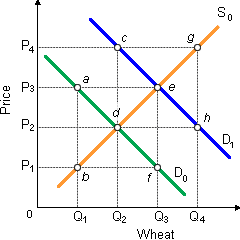Assume that recent advances within agricultural technology resulted into the U.S. wheat market being at a first equilibrium upon S0D0. Farmers complain which gluts within the wheat market have depressed their incomes, endangering the family farm. Assume that now the government institutes a legal price floor at P3 per bushel of wheat beneath a program termed as parity pricing. One outcome will be like: (w) an annual surplus of wheat equal to distance ae. (x) decreases into the prices of bread and pasta. (y) an annual shortage of wheat equivalent to distance bf. (z) increases in farm income therefore total farm revenues equal area 0P4gQ4.

Please choose the right answer from above...I want your suggestion for the same.